Top Rankings
City Academy School District ranks among the top 20% of public school district in Minnesota for:
Category
Attribute
Science Proficiency
Highest science proficiency (Top 20%)
Diversity
Most diverse schools (Top 1%)
For the 2025 school year, there are 2 public high schools serving 122 students in City Academy School District.
Public High Schools in City Academy School District have an average math proficiency score of 50% (versus the Minnesota public high school average of 36%).
Public High School in City Academy School District have a Graduation Rate of 57%, which is less than the Minnesota average of 83%.
The school with highest graduation rate is City Academy, with 55-59% graduation rate. Read more about public school graduation rate statistics in Minnesota or national school graduation rate statistics.
Minority enrollment is 96% of the student body (majority Asian and Black), which is more than the Minnesota public high school average of 37% (majority Hispanic and Black).
Overview
This School District
This State (MN)
# Schools
2 Schools
1,177 Schools
# Students
122 Students
310,035 Students
# Teachers
9 Teachers
18,776 Teachers
Student : Teacher Ratio
14:1
14:1
District Rank
The school district's graduation rate of 55-59% has decreased from 65-69% over five school years.
Math Test Scores (% Proficient)
<50%
45%
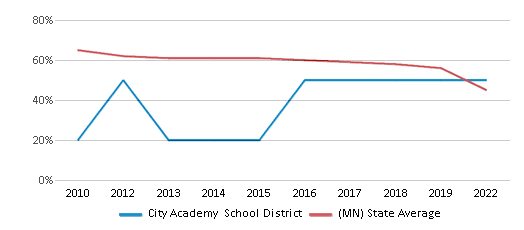
Reading/Language Arts Test Scores (% Proficient)
(17-18)<50%
60%
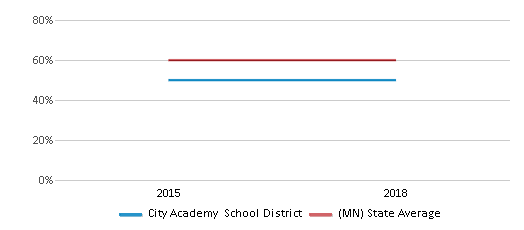
Science Test Scores (% Proficient)
<50%
41%
Graduation Rate
55-59%
84%
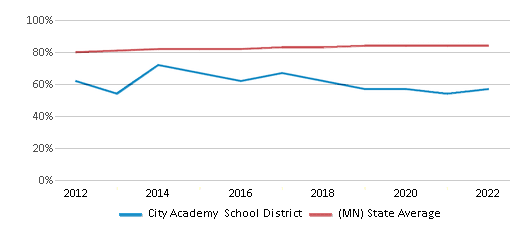
Students by Ethnicity:
Diversity Score
0.73
0.57
# American Indian Students
2 Students
6,364 Students
% American Indian Students
2%
2%
# Asian Students
44 Students
19,892 Students
% Asian Students
36%
7%
# Hispanic Students
13 Students
35,225 Students
% Hispanic Students
11%
11%
# Black Students
42 Students
34,141 Students
% Black Students
34%
11%
# White Students
5 Students
196,402 Students
% White Students
4%
63%
# Hawaiian Students
n/a
317 Students
% Hawaiian Students
n/a
n/a
# Two or more races Students
16 Students
17,694 Students
% of Two or more races Students
13%
6%
Students by Grade:
# Students in PK Grade:
-
229
# Students in K Grade:
-
120
# Students in 1st Grade:
-
204
# Students in 2nd Grade:
-
210
# Students in 3rd Grade:
-
264
# Students in 4th Grade:
-
305
# Students in 5th Grade:
-
384
# Students in 6th Grade:
-
3,144
# Students in 7th Grade:
-
11,219
# Students in 8th Grade:
-
12,649
# Students in 9th Grade:
-
67,716
# Students in 10th Grade:
3
69,634
# Students in 11th Grade:
18
69,942
# Students in 12th Grade:
101
74,015
# Ungraded Students:
-
-
District Revenue and Spending
The revenue/student of $16,582 in this school district is less than the state median of $17,854. The school district revenue/student has stayed relatively flat over four school years.
The school district's spending/student of $15,697 is less than the state median of $18,580. The school district spending/student has stayed relatively flat over four school years.
Total Revenue
$2 MM
$15,547 MM
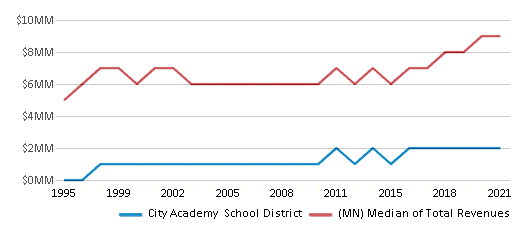
Spending
$2 MM
$16,179 MM

Revenue / Student
$16,582
$17,854
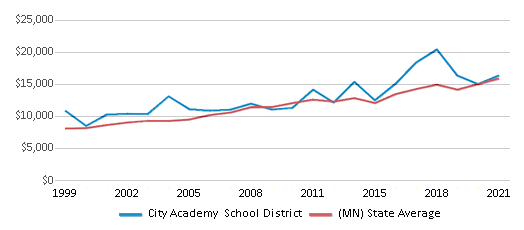
Spending / Student
$15,697
$18,580

Best City Academy School District Public High Schools (2025)
School
(Math and Reading Proficiency)
(Math and Reading Proficiency)
Location
Grades
Students
Rank: #11.
City Academy
Charter School
(Math: ≤20% | Reading: <50% )
Rank:
Rank:
3/
Bottom 50%10
958 Jessie St
Saint Paul, MN 55130
(651) 298-4624
Saint Paul, MN 55130
(651) 298-4624
Grades: 9-12
| 122 students
Rank: n/an/a
City Academy Online
Charter School
958 Jessie St
Saint Paul, MN 55130
(651) 298-4624
Saint Paul, MN 55130
(651) 298-4624
Grades: 9-12
| n/a students
Recent Articles

Year-Round Or Traditional Schedule?
Which is more appropriate for your child? A year-round attendance schedule or traditional schedule? We look at the pros and cons.

Why You Should Encourage Your Child to Join a Sports Team
Participating in team sports has a great many benefits for children, there is no doubt. In this article you will learn what those benefits are.

White Students are Now the Minority in U.S. Public Schools
Increasing birth rates among immigrant families from Asia and Central and South America, combined with lower birth rates among white families, means that for the first time in history, public school students in the United States are majority-minority. This shift in demographics poses difficulties for schools as they work to accommodate children of varying language abilities and socio-economic backgrounds.





